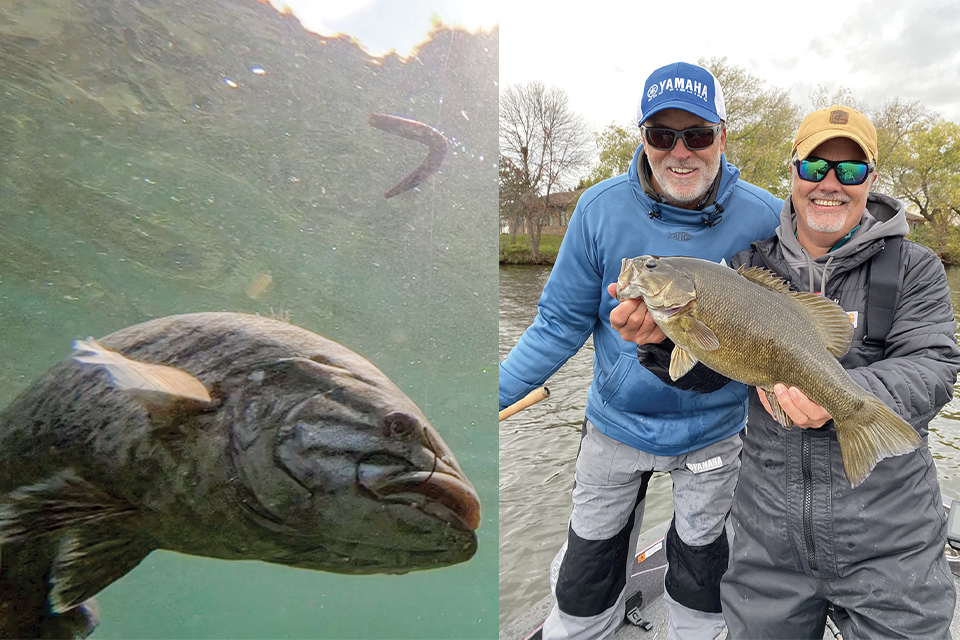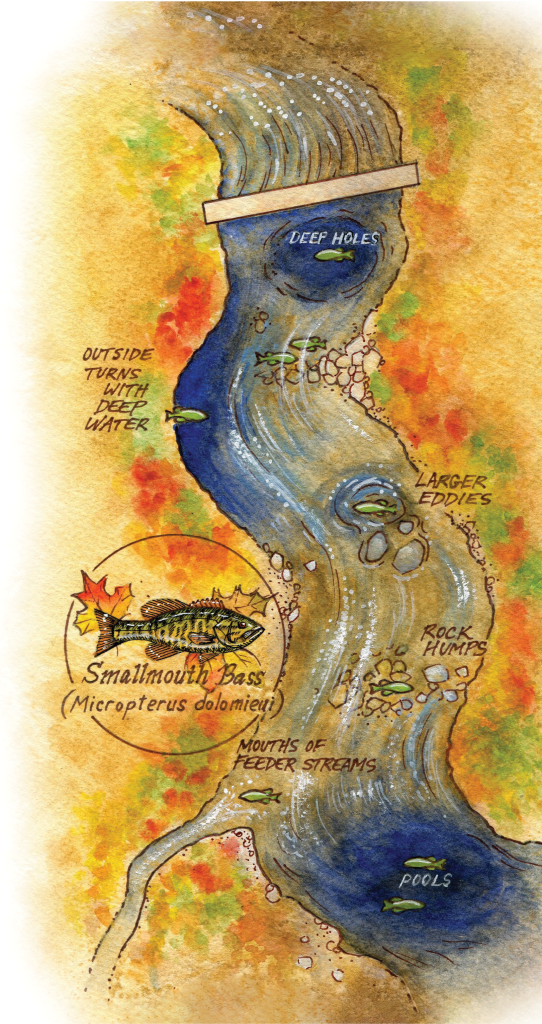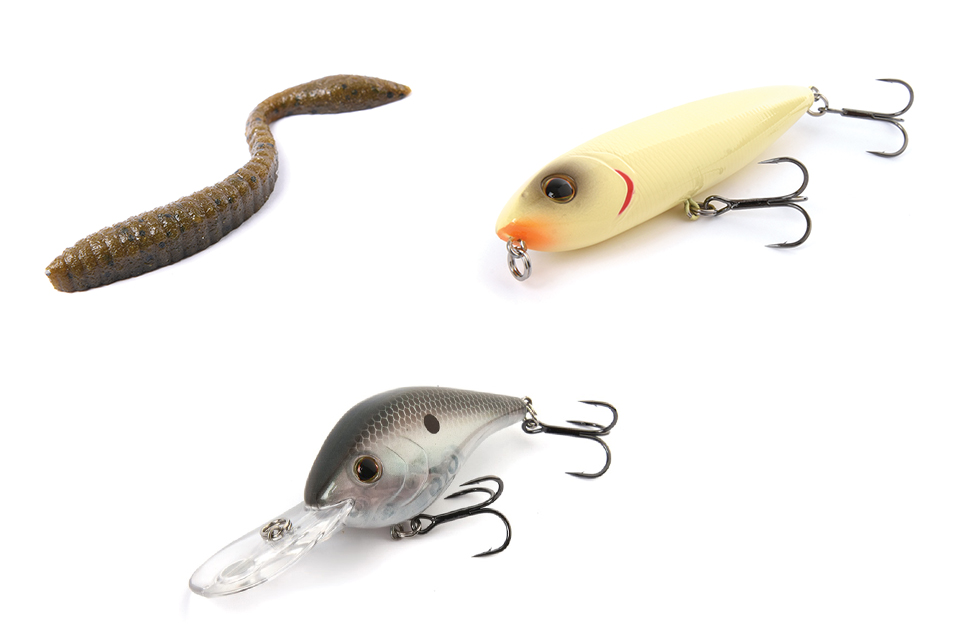
Yep, few fish are more frustrating than smallmouth, which have a habit of shutting down or disappearing just when you think you have everything figured out.
Seth Feider must agree. I had to chuckle when the 2021 Bassmaster Angler of the Year muttered “stupid smallmouth” during the Bassmaster Elite Series tourney on Lake Champlain last July. But there is a time — yes, outside the spawn — when smallmouth movement becomes predictable, even reliable. Hit the right waters at the right times, and odds are you’ll find stacked fish feeding aggressively.
That window is mid- to late fall on rivers in those parts of the country where water temps slide from the 60s into the 40s as winter takes hold. In most cases that means Northern waters, but not always. There are variations to consider — river size, water depths, dam locations, forage and more — but the puzzle is worth putting together, because once you have it figured out, the fishing can be incredible.

Keys to understand
It’s important to understand something about river smallmouth in colder climes: They move, a lot, especially in fall and spring.
Smallmouth migration to wintering areas has been studied and confirmed on many waters, including the Snake River in Idaho, Wisconsin’s Wolf River, the Susquehanna in Pennsylvania and many others. Some of these studies date back as much as 60 years, though most are more recent.
In one study, conducted in 1994 on a stretch of the Mississippi River in Minnesota that I fish often, 30 adult smallmouth were surgically implanted with radio transmitters then tracked for a 12-month period.
Research showed smallmouth migrated an average of 18 miles each fall to wintering areas, usually targeting deeper-water areas downstream of where they spend their summer months, but there are upstream migrators as well.
One fish in the study traveled nearly 25 miles in just 14 days, passing through three dams in the process.
In a different study, this time on the Susquehanna in Pennsylvania, smallmouth traveled up to 56 miles during their fall migration.
Fall movement is closely tied to seasonal change, whether it’s the shorter days of fall, dropping water temperatures or a combination of both.
I rely on water temps more than the calendar as fall has been staying warmer for longer, at least where I fish. Even so, fish locations remain predictable during normal water level years as temps eventually begin to cool.
When surface temps dip below 60 degrees, smallmouth activity increases. Fish begin to move and feed more often, but not all follow the same script.
As fall progresses, smallmouth start to congregate in schools and stop in predictable locations — deep pools, eddies, rock humps, outside bends — en route to wintering holes. These stops may last days before the fish move to the next stop on their push to their winter holding areas.
Migrating fish may leave long stretches of water virtually smallmouth-free, particularly shallow stretches of rivers with limited habitat for overwintering fish.
Warming trends that raise water temps rapidly can actually hurt the fall (and spring!) bite. I’ve started calling these warming trends “reverse cold fronts” because fish respond in the same way: The bite slows.
Once waters reach the low 40s, smallmouth have settled into their wintering holes. In rivers with dams, one of the most commonly used holding areas is found in the deeper, slacker water above a dam.
But don’t think you need to target the area immediately above the dam. Some of the best spots may be miles above the dam, especially in shallow rivers with few pools or a deep main channel.
Most rivers tend to see large concentrations of adult fish in small areas that offer the magic combination of depth, hard bottom, slack water, stable temps and ample forage (mostly crawfish).
Finding fall smallmouth
After a lifetime of chasing river smallmouth across several states and multiple Canadian provinces, I’ve learned all waters are unique, but they also share characteristics with other fisheries, even those thousands of miles away. This allows you to take what you learn on the waters you fish and apply it to other fisheries.
Small, shallow rivers are very common across the country, and many are sleeper smallmouth fisheries because few anglers bother to fish them, though that is changing. One river I fish often in the fall is so shallow about the only place you can float a bass boat is above the river’s only dam and maybe 2 miles upstream, but it produces giant smallmouth every fall.
Another river is a much larger water body with a channel deep enough to support boat traffic, but smallmouth still congregate in big numbers each fall in the deeper areas above the dam. Deep, outside bends are key on this particular river.

Key presentations for fall migrators
When you target fall smallmouth, start the day with a plan to focus on key areas to avoid areas that are likely holding only a few or even no bass. This is not the time to run long stretches of featureless bank or work midriver riffles looking for fish. Instead, look for areas with potential to hold larger schools.
Your electronics are key. On rivers that are mapped, use mapping to locate potential hot spots: outside turns with deep water, larger eddies, pools, wing dams, mouths of feeder streams and deep holes immediately above the dam.
Forward-facing sonar and side imaging are important, especially for locating areas of rock and current breaks.
Fish location will determine which presentations make sense to use.
If fish are shallow and active, topwaters can be dynamite early to midseason. Poppers, buzzbaits, rear-props and walkers all have their days, especially when fish are relating to shoreline rock and overhead cover. Occasional pausing to allow the bait to move with the current often triggers bites from bass that will ignore a moving bait.
I am a fan of cranks in the fall, especially when fish are holding over rocks that break into deeper water. Models like the Berkley Frittside 5 or 7 are ideal for shallow fish, while the Berkley Dredger 10.5 is a great option for fishing the 7- to 10-foot range.
Craw patterns are always a good choice with cranks, but baitfish patterns can also be dynamite.
Fish crankbaits on a medium or medium-fast action rod to maintain more contact with the bait. This allows you to work breaklines more effectively and detect leaves and other debris commonly hooked in fall rivers.
I like slower reels in the fall, starting with a 6.4:1 or 7.1:1, but if the fish allow, I will bump up retrieve speed when possible. Ten-pound fluoro is a solid line choice on baitcasting gear.
Last fall, fishing with Bassmaster Editor-in-Chief James Hall on a stretch of the upper Mississippi River during a windy, brutally cold late October day, we found smallmouth stacked over shoreline-connected rock splines that ended in 12 to 14 feet of water. We also found schools of smallmouth holding in deep depressions midriver.
We caught several bass throwing cranks, but most of the fish were small. A switch to swimbaits killed the bite completely, and a move to jigs and craws yielded the same results.
So, we switched to a drop shot. It was the right move. We caught several big fish on Berkley PowerBait MaxScent Flat Worms. The key was going heavy enough (3/8 ounce) to pin the rig to the bottom to prevent most snags and working the bait slowly when a fish approached.
Garmin LiveScope showed both fish and their response, making it easier to trigger more bites.
Other soft baits are historically good producers. I like 2.5- and 3-inch tubes, swimming grubs and small swimbaits fished on a mushroom-head jig from 1/16 to about 1/4 ounce.
Swim jigs and traditional football-head jigs are good options. I like heavy football heads when working deep rock in areas of faster current. Tip them with a craw trailer or a smaller swimbait and work them downcurrent, staying near the bottom.
Now is the time!
Expect this bite to last for several weeks on most waters, peaking when water temps are in the 50s and high 40s, then slowing when temps slide into the low 40s. Plan to hit spots that produced earlier, as good spots typically reload as new fish move in when others move on.
Smallmouth activity slows once water temps hit the low 40s, making fish tough to catch no matter where you are in bass country.
To find good water near you, spend an hour or two with your electronics and study mapping of the rivers before you go. You may unlock a key to great fall action in places other anglers simply ignore or don’t even know about, and that bodes well for great fishing.
Originally appeared in Bassmaster Magazine 2022.




